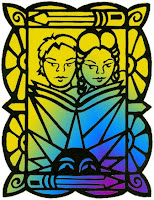 It’s hard to believe that it’s been ten years since the first celebration of El Día de los Niños/El Día de los Libros, (The Day of the Child/ The Day of the Book) on April 30, 1997, sprung from an idea that poet, author and literacy advocate Pat Mora had, and that REFORMA supported. It has since mushroomed into a grassroots effort on a national scale. And this year for the first time, a Día event is planned for the U.S. Senate. Senators will read to children from the nearby Oyster Bilingual School, ALSC President KT Horning and a representative from La Raza will speak, and children in attendance will receive goodie bags filled with books donated from publishers, plus bookmarks, stickers, and magnets.
It’s hard to believe that it’s been ten years since the first celebration of El Día de los Niños/El Día de los Libros, (The Day of the Child/ The Day of the Book) on April 30, 1997, sprung from an idea that poet, author and literacy advocate Pat Mora had, and that REFORMA supported. It has since mushroomed into a grassroots effort on a national scale. And this year for the first time, a Día event is planned for the U.S. Senate. Senators will read to children from the nearby Oyster Bilingual School, ALSC President KT Horning and a representative from La Raza will speak, and children in attendance will receive goodie bags filled with books donated from publishers, plus bookmarks, stickers, and magnets.Pat Mora continues her efforts as a literacy advocate in promoting El Día de los Niños/El Día de los Libros held every April 30th. Many of her own works are written in two languages (English interwoven with Spanish words and phrases), and in bilingual editions. She reflects her own feelings and experiences growing up in the Southwest in her poems in This Big Sky (Scholastic, 1998), creates rhyming ABC and counting books for younger children with ¡Marimba!: Animales from A to Z (Clarion, 2006) and Uno Dos Tres, One, Two, Three (Clarion, 1996), and writes for middle grade kids and teens with Confetti: Poems for Children (Lee & Low, 1996/1999), and My Own True Name: New and Selected Poems for Young Adults (Arte Publico Press, 2000). Mora has also created an anthology of poetry by other Latino/Latina poets in Love to Mama: A Tribute to Mothers (Lee & Low, 2001).
Start planning now for your own Día celebration for next April 30! Look for poetry that celebrates the unique cultures and languages in your own community. And for connecting with communities across the globe, look for these collections of poetry for young people by poets OUTSIDE our U.S. borders:
Agard, John and Grace Nichols, ed. 1994. A Caribbean Dozen: Poems from Caribbean Poets. Cambridge, MA: Candlewick.
Benjamin, Floella, comp. 1995. Skip Across the Ocean: Nursery Rhymes from Around the World. New York: Orchard Books.
Brenner, Barbara. 2000. Voices: Poetry and Art from Around the World. Washington, DC: National Geographic Society.
Cashman, Seamus, 2004. Something Beginning with P; New Poems From Irish Poets. O’Brien Press. (See entry for March 17)
Delacre, Lulu. 2004. Arrorró Mi Niño: Latino Lullabies and Gentle Games. New York:
Lee & Low Books.
Gunning, Monica. 1998. Under The Breadfruit Tree: Island Poems. Honesdale, PA: Boyds Mills Press.
Ho, Minfong. 1996. Maples in the Mist: Poems for Children from the Tang Dynasty. New York: Lothrop, Lee, & Shepard.
Lee, Dennis. 1999. The Ice Cream Store. New York: HarperCollins.
Mado, Michio. 1998. The Magic Pocket. New York: Margaret K. McElderry Books.
Nye, Naomi Shihab, comp. 1998. The Space Between Our Footsteps: Poems and Paintings From the Middle East. New York: Simon & Schuster.
___, comp. 1992. This Same Sky: A Collection of Poems from Around the World. New York: Four Winds Press.
___, comp. 1995. The Tree is Older than You Are: A Bilingual Gathering of Poems and Stories from Mexico with Paintings by Mexican Artists. New York: Simon & Schuster.
Orozco, Jose-Luis. 2002. Diez Deditos: Ten Little Fingers and Other Play Rhymes and Action Songs from Latin America. New York: Dutton.
Pomerantz, Charlotte. 1982. If I Had a Paka: Poems in Eleven Languages. New York: Greenwillow.
Prelutsky, Jack, comp. 1997. Dinosaur Dinner with a Slice of Alligator Pie: Favorite Poems by Dennis Lee. New York: Scholastic.
Rosen, Michael, comp. 1992. Itsy-bitsy Beasties: Poems from Around the World. Minneapolis, MN: Carolrhoda Books.
Schmidt, Annie M.G. 1981. Pink Lemonade: Poems for Children. Translated and adapted from the Dutch by Henrietta ten Harmsel. Grand Rapids, MI: Eerdmans.
Yolen, Jane. 2000. Street Rhymes From Around the World. Honesdale, PA: Boyds Mills Press.
For more suggestions, see also posts for April 2: International Book Day and Sept. 22: Poetry Around the World
Every poet is a big child.
And every child is a little poet.
Childhood is the poetry of life.
Poetry is the childhood of the world.
Boris Novak, Poet
[From: Kordigel, M. (1995). "Every poet a big child": The Slovene poet Boris A. Novak. Bookbird. 33, 1, 36-37.]
Picture credit: http://www.texasdia.org/




















